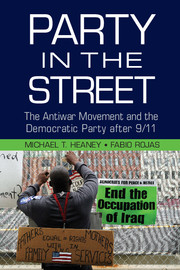Book contents
- Frontmatter
- Dedication
- Contents
- List of Tables
- List of Figures
- List of Abbreviations
- Introduction
- 1 The Party in the Street and Its Historical Context
- 2 Partisan Politics at the Water's Edge?
- 3 Multiple Identities and Party-Movement Interaction
- 4 Identities and Grassroots Participation
- 5 Identities and Organizational Action
- 6 Identities and Legislative Agendas
- 7 Beyond the Antiwar Movement and the Democratic Party
- 8 Social Movements in a Polarized America
- Epilogue
- Appendixes
- References
- Index
7 - Beyond the Antiwar Movement and the Democratic Party
Published online by Cambridge University Press: 05 February 2015
- Frontmatter
- Dedication
- Contents
- List of Tables
- List of Figures
- List of Abbreviations
- Introduction
- 1 The Party in the Street and Its Historical Context
- 2 Partisan Politics at the Water's Edge?
- 3 Multiple Identities and Party-Movement Interaction
- 4 Identities and Grassroots Participation
- 5 Identities and Organizational Action
- 6 Identities and Legislative Agendas
- 7 Beyond the Antiwar Movement and the Democratic Party
- 8 Social Movements in a Polarized America
- Epilogue
- Appendixes
- References
- Index
Summary
Our empirical analysis to this point in the book focuses on interaction between the antiwar movement and the Democratic Party. Nonetheless, we argue that the concept of the party in the street applies beyond this party-movement pair. Social movements and political parties vary from pair to pair in the extent to which they overlap with one another; as a result, the party in the street may constitute anywhere from a relatively large share of party-movement activity to a relatively small fraction of that activity. The size of the party in the street may vary across time, as well as across party-movement pairs. What difference, if any, do these fluctuations make?
The size of the party in the street reflects the balance of power within both the party and the movement. When the party in the street is small, neither the party nor the movement has many incentives to accede to its demands. In this case, party leaders receive little electoral benefit from addressing movement issues, while movement leaders only lose grassroots support by compromising with the party. When the party in the street is large, however, the incentives are reversed because the balance of power is its favor. Party leaders may worry that failing to address the concerns of the movement may have negative electoral consequences, especially in primary elections (Boatright 2013). Movement leaders know that their grassroots supporters identify strongly with the party, so they are more likely to keep these supporters happy by coordinating their efforts with the party's agenda.
- Type
- Chapter
- Information
- Party in the StreetThe Antiwar Movement and the Democratic Party after 9/11, pp. 205 - 228Publisher: Cambridge University PressPrint publication year: 2015



